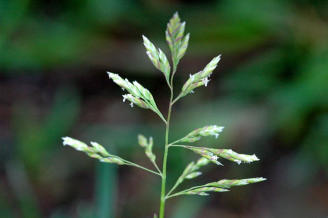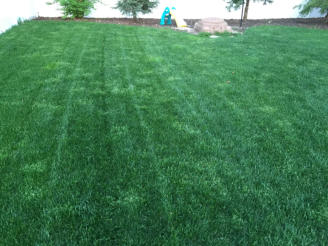
Annual Bluegrass (poa annua)



Ultralawn Incorporated
1055 East 260th Street
Euclid, OH 44132
216.731.7756
440.951.3738
Office hours Monday-Friday 9-3 call today with any questions

Annual bluegrass is a problematic winter annual grassy weed in
residential turf. Compared to most turfgrasses, annual
bluegrass has a lighter green color, coarser leaf texture and
produces unsightly seedheads.
Annual bluegrass seed germinates in late summer/early fall
once soil temperatures fall below 70° F. Seedlings grow and
mature in fall through winter in a vegetative state and produce
seed in spring. Annual bluegrass is a prolific seed producer and
individual plants may produce hundreds of viable seed, even
when closely mowed. Annual bluegrass flowers over several
months in spring and produces seed that may remain dormant
in soil for years before germinating. Annual bluegrass grows
well under short day lengths and cool conditions, and may out-compete other turf species during late fall and
early spring. Annual bluegrass often dies from summer stresses but may survive if irrigated and if pests are
adequately controlled.
Several cultural practices can be utilized to control annual
bluegrass in residential lawns. Deep and infrequent irrigation
encourages turfgrass root development, which may improve the
ability of desired grasses to compete with annual bluegrass in
mixed stands. Withholding water until desirable turfgrass
species exhibit initial drought stress symptoms can help reduce
soil moisture for potential annual bluegrass infestations. Over
watering, especially in shady areas, may predispose the site to
annual bluegrass invasion.
Practices that promote soil compaction should be avoided to
promote turfgrass growth and competition with annual
bluegrass populations. Core aerations should be conducted
during active turf growth and favorable periods for quick
recovery. Voids left in turf with exposed soil following aerations
may permit annual bluegrass invasion during periods of peak
germination. For cool-season grasses, fall aerations should be timed before annual bluegrass germinates.
Warm-season grasses should have enough time to recover from summer aerations to promote dense, high
quality turf prior to annual bluegrass germination in fall.
Raising the mowing height during peak annual bluegrass germination may encourage turf competition to
reduce potential infestations. Lower mowing heights may predispose turf to stress and reduce competition
with annual bluegrass populations. Turfgrass should also be mowed frequently during periods of vigorous
growth to prevent scalping. Scalping thins out turf and may enable weeds, such as annual bluegrass, to
establish. While returning clippings is recommended to recycle nutrients to the soil, removal of clippings may
be useful when annual bluegrass is present and producing seedheads. Removal of clippings at this time will
reduce the spread of viable seed.


Close up of Annual Bluegrass seedhead
The lighter patches are Annual Bluegrass in a maintained lawn


















